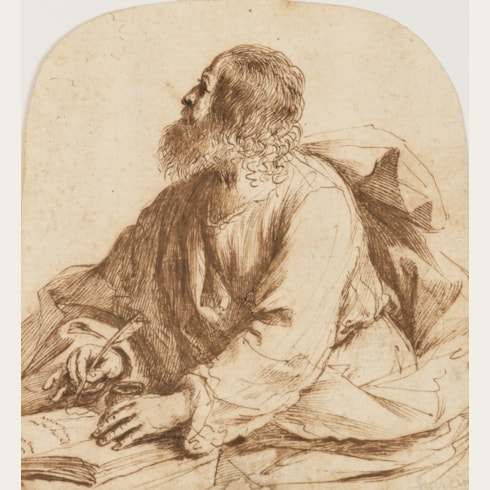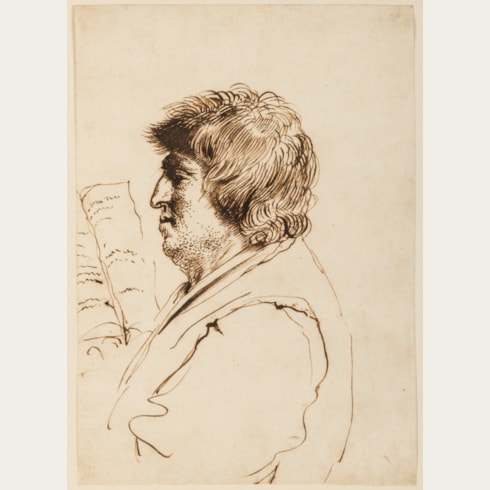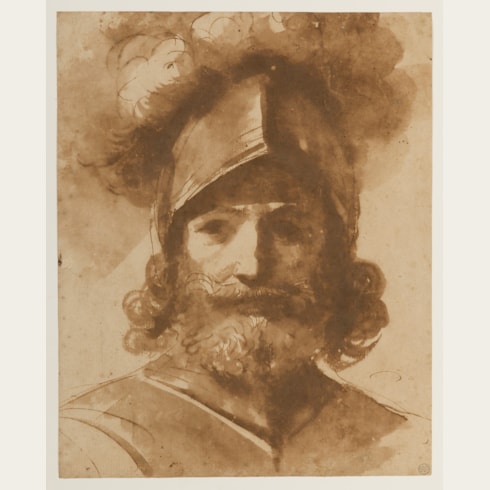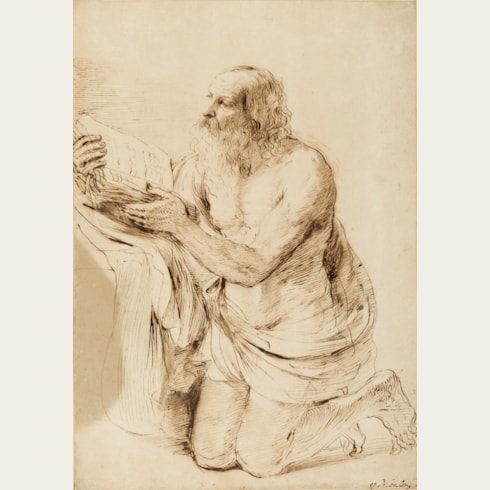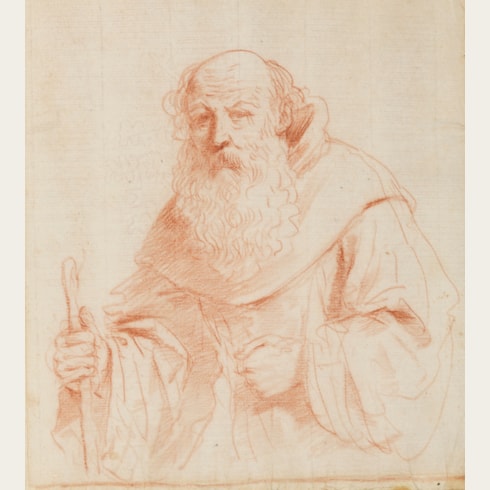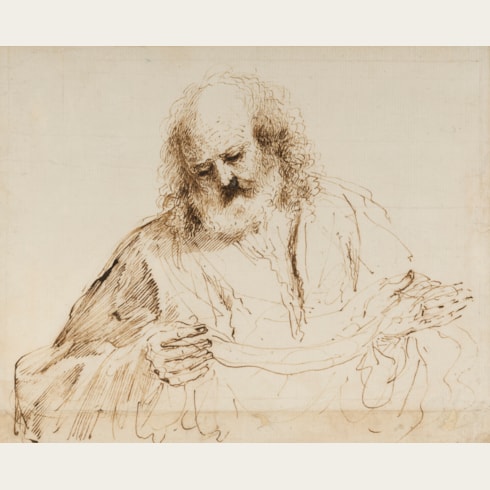Giovanni Francesco Barbieri GUERCINO
(Cento 1591 - Bologna 1666)
The Head and Torso of a Bearded Old Man
187 x 188 mm. (7 3/8 x 7 3/8 in.)
Watermark: A star above a cartouche with a fleur-de-lys and papal keys.
This drawing may be compared stylistically with a damaged study of an old bearded man in profile to the right, in the Royal Collection at Windsor Castle, which is drawn on the reverse of a letter dated Cento 1638. Also somewhat similar is the head and torso of an elderly bearded saint in profile to the right found in a red chalk drawing at Chatsworth. As one scholar has noted, ‘the texture of hair seems to have fascinated Guercino, and few draftsmen represented it as adeptly. Whether head-born or face-worn, hair is used subtly to bring a sense of verisimilitude and realism to Guercino’s figures and compositions.’
Spirited pen and ink drawings such as this Head and Torso of a Bearded Old Man display Guercino’s innate talent as a draughtsman to the full. As the scholar and curator Carel van Tuyll has noted, ‘For all their functionality…Guercino’s drawings are also clear evidence of how much he enjoyed the medium for its own sake, and of his (justified) pride in his virtuosity: the calligraphic flourish of his pen lines and the vigour of his washes have always been admired…What makes Guercino’s drawings so appealing to modern eyes is in fact their spontaneity, the evidence they provide of an endlessly fertile imagination and a truly baroque creative urgency.’
Drawings such as this have long been some of the most esteemed of the artist’s works among collectors and connoisseurs. As the early 19th century Irish art critic William Paulet Carey wrote of Guercino, ‘He contributed largely to the treasury of genius, and will ever rank as a bold original among the great masters. This originality is still more strongly marked in his drawings, which are numerous, and highly prized in all classic collections…Produced with strokes, and dashes, rapid and full of life and vigour; like sparks of flame struck forth by collision, they are more strongly impregnated with the fire of his unmitigated feelings…In Guercino’s drawings, the boldness of hand, the roughness of touch and surface, were subordinate results of real power; the necessary means of vigorous expression, character, and effect.’
The present sheet was part of the extensive collection of more than two hundred drawings by Guercino assembled in the 1920s by the American collector Dan Fellows Platt (1873-1938). Most, but not all, of Platt’s outstanding collection of Italian drawings, which also included large groups of studies by Luca Cambiaso, Giambattista and Domenico Tiepolo and Salvator Rosa, were later presented to the Princeton University Art Museum in New Jersey. This drawing, however, was acquired by the Irish-American bibliophile and collector James Gilvarry (1914-1984) of New York, and was later in the collection of the Italian scholar and art historian Prisco Bagni (1921-1995), a native of Cento who published several important studies on Guercino and his studio, as well as on the Gandolfi family of artists.
Giovanni Francesco Barbieri, known as Il Guercino (‘the squinter’) because he was cross-eyed, was by the second decade of the 17th century one of the leading painters in the province of Emilia. Born in Cento, a small town between Bologna and Ferrara, Guercino was largely self-taught, although his early work was strongly influenced by the paintings of Ludovico Carracci. In 1617 he was summoned to Bologna by Alessandro Ludovisi, the Cardinal Archbishop of Bologna, and there painted a number of important altarpieces, typified by the Saint William Receiving the Monastic Habit, painted in 1620 and now in the Pinacoteca Nazionale in Bologna. When Ludovisi was elected Pope Gregory XV in 1621, Guercino was summoned to Rome to work for the pontiff and his nephew, Cardinal Ludovico Ludovisi. It was in Rome that Guercino painted some of his most celebrated works, notably the ceiling fresco of Aurora in the Casino Ludovisi and the large altarpiece of The Burial and Reception into Heaven of Saint Petronilla for an altar in Saint Peter’s. The papacy of Gregory XV was short-lived, however, and on the death of the Pope in 1623 Guercino returned to his native Cento. He remained working in Cento for twenty years, though he continued to receive commissions from patrons throughout Italy and beyond, and turned down offers of employment at the royal courts in London and Paris. Following the death of Guido Reni in 1642, Guercino moved his studio to Bologna, where he received commissions for religious pictures of the sort that Reni had specialized in, and soon inherited his position as the leading painter in the city.
Guercino was among the most prolific draughtsmen of the 17th century in Italy, and his preferred medium was pen and brown ink, although he also worked in red chalk, black chalk, and charcoal. He appears to have assiduously kept his drawings throughout his long career, and to have only parted with a few of them. Indeed, more drawings by him survive today than by any other Italian artist of the period. On his death in 1666 all of the numerous surviving sheets in his studio passed to his nephews and heirs, the painters Benedetto and Cesare Gennari, known as the ‘Casa Gennari’.
The drawings of Guercino, which include figural and compositional studies, landscapes, caricatures and genre scenes, have always been coveted by later collectors and connoisseurs. Indeed, the 18th century amateur Pierre-Jean Mariette noted of the artist that ‘Ce peintre a outre cela une plume tout-à-faite séduisante’. The largest extant group of drawings by Guercino is today in the Royal Collection at Windsor Castle; these were acquired from the Gennari family by King George III’s librarian, Richard Dalton, between about 1758 and 1764.
Provenance
By descent to Cesare Gennari’s grandson, Carlo Gennari, Bologna
Probably Francesco Forni, Bologna
Acquired in the 1740s by John Bouverie, Betchworth, Surrey
By descent to his sister, Anne Bouverie, Betchworth, Surrey, until 1757
Her son, Christopher Hervey, London and Betchworth, Surrey, until 1786
His aunt, Elizabeth Bouverie, Barham Court, Teston, Kent, until 1798
Bequeathed to Sir Charles Middleton, later 1st Baron Barham, Barham Court, Kent
By descent to his grandson, Charles Noel, 3rd Baron Barham and later 1st Earl of Gainsborough of the second creation
Thence by descent in the collection of the Earls of Gainsborough, Exton Park, Oakham, Rutland
Possibly their sale (‘Drawings by Old Masters, The Property of The Rt. Hon. The Earl of Gainsborough, Of Exton Park, Oakham, Rutlandshire’), London, Christie’s, 27 July 1922, part of lots 84 or 85 (bt. Parsons)
E. Parsons and Sons, London (according to the inscription on the old backing sheet)
Acquired from them in c.1920 by Dan Fellows Platt, Englewood, New Jersey (his estate stamp [Lugt 750a] stamped on the verso and also on the old backing sheet)
James Gilvarry, New York
His sale, London, Christie’s, 6 July 1977, lot 86
Prisco Bagni, Bologna
Thence by descent.
Literature






















